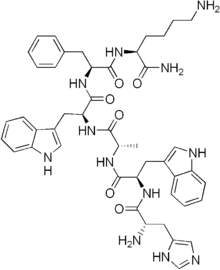GHRP-6
 | |
| Clinical data | |
|---|---|
| ATC code | None |
| Pharmacokinetic data | |
| Biological half-life | 2.5 hours[1] |
| Identifiers | |
| |
| CAS Number |
87616-84-0 |
| PubChem (CID) | 5486806 |
| ChemSpider |
26333269 |
| Chemical and physical data | |
| Formula | C46H56N12O6 |
| Molar mass | 873.014 g/mol |
| 3D model (Jmol) | Interactive image |
| |
| |
| | |
Growth hormone-releasing peptide 6 (GHRP-6) (developmental code name SKF-110679), also known as growth hormone-releasing hexapeptide, is one of several synthetic met-enkephalin analogues that include unnatural D-amino acids, were developed for their growth hormone-releasing activity and are called growth hormone secretagogues. They lack opioid activity but are potent stimulators of growth hormone (GH) release. These secretagogues are distinct from growth hormone releasing hormone (GHRH) in that they share no sequence relation and derive their function through activation of a completely different receptor. This receptor was originally called the growth hormone secretagogue receptor (GHSR), but due to subsequent discoveries, the hormone ghrelin is now considered the receptor's natural endogenous ligand, and it has been renamed as the ghrelin receptor. Therefore, these GHSR agonists act as synthetic ghrelin mimetics.
It has been discovered that when GHRP-6 and insulin are administered simultaneously, GH response to GHRP-6 is increased (1). However, the consumption of carbohydrates and/or dietary fats, around the administration window of GH secretagogues significantly blunts the GH release. A recent study in normal mice showed significant differences in body composition, muscle growth, glucose metabolism, memory and cardiac function in the mice being administered the GHRP-6 (2). There are still many questions regarding this fairly new compound, scientists are hoping to gain a better clinical understanding of the peptide through further research over the next few years.
GH secretagogues differ from exogenous rHGH in their effects primarily because endogenous GH contains all five isoforms of growth hormone, whereas exogenous GH contains only the 20 kilodalton isoform. Different isoforms affect tissues in discreet ways that the 20 kDa isoform cannot. Administration of GH secretagogues causes a pulse-release of GH from the pituitary which is cleared from the body within a few hours. This does not significantly raise plasma insulin-like growth factor 1 (IGF-1) levels.
See also
- Anamorelin
- Capromorelin
- Examorelin (hexarelin)
- Ibutamoren (MK-677)
- Ipamorelin
- Macimorelin
- Pralmorelin (GHRP-2)
- Relamorelin
- SM-130,686
- Tabimorelin
References
- ↑ Cabrales A, Gil J, Fernández E, Valenzuela C, Hernández F, García I, Hernández A, Besada V, Reyes O, Padrón G, Berlanga J, Guillén G, González LJ (2013). "Pharmacokinetic study of Growth Hormone-Releasing Peptide 6 (GHRP-6) in nine male healthy volunteers". Eur J Pharm Sci. 48 (1-2): 40–6. doi:10.1016/j.ejps.2012.10.006. PMID 23099431.
- Korbonits M, Goldstone AP, Gueorguiev M, Grossman AB (2004). "Ghrelin--a hormone with multiple functions". Frontiers in neuroendocrinology. 25 (1): 27–68. doi:10.1016/j.yfrne.2004.03.002. PMID 15183037.
- Peñalva, A; Carballo, A; Pombo, M; Casanueva, FF; Dieguez, C (1993). "Effect of growth hormone (GH)-releasing hormone (GHRH), atropine, pyridostigmine, or hypoglycemia on GHRP-6-induced GH secretion in man". The Journal of Clinical Endocrinology and Metabolism. 76 (1): 168–71. doi:10.1210/jc.76.1.168. PMID 8421084.
- Camanni, F; Ghigo, E; Arvat, E (1998). "Growth hormone-releasing peptides and their analogs". Frontiers in neuroendocrinology. 19 (1): 47–72. doi:10.1006/frne.1997.0158. PMID 9465289.
- Adeghate, E; Ponery, AS (2002). "Ghrelin stimulates insulin secretion from the pancreas of normal and diabetic rats". Journal of neuroendocrinology. 14 (7): 555–60. doi:10.1046/j.1365-2826.2002.00811.x. PMID 12121492.
- McGirr, R; McFarland, MS; McTavish, J; Luyt, LG; Dhanvantari, S (2011). "Design and characterization of a fluorescent ghrelin analog for imaging the growth hormone secretagogue receptor 1a". Regulatory peptides. 172 (1-3): 69–76. doi:10.1016/j.regpep.2011.08.011. PMID 21893106.
- Koh, B., & Hardie, M. (2013). We need an advocate against ASADA’s power in doping control. Retrieved from https://theconversation.edu.au/we-need-an-advocate-against-asadas-power-in-doping-control-12119